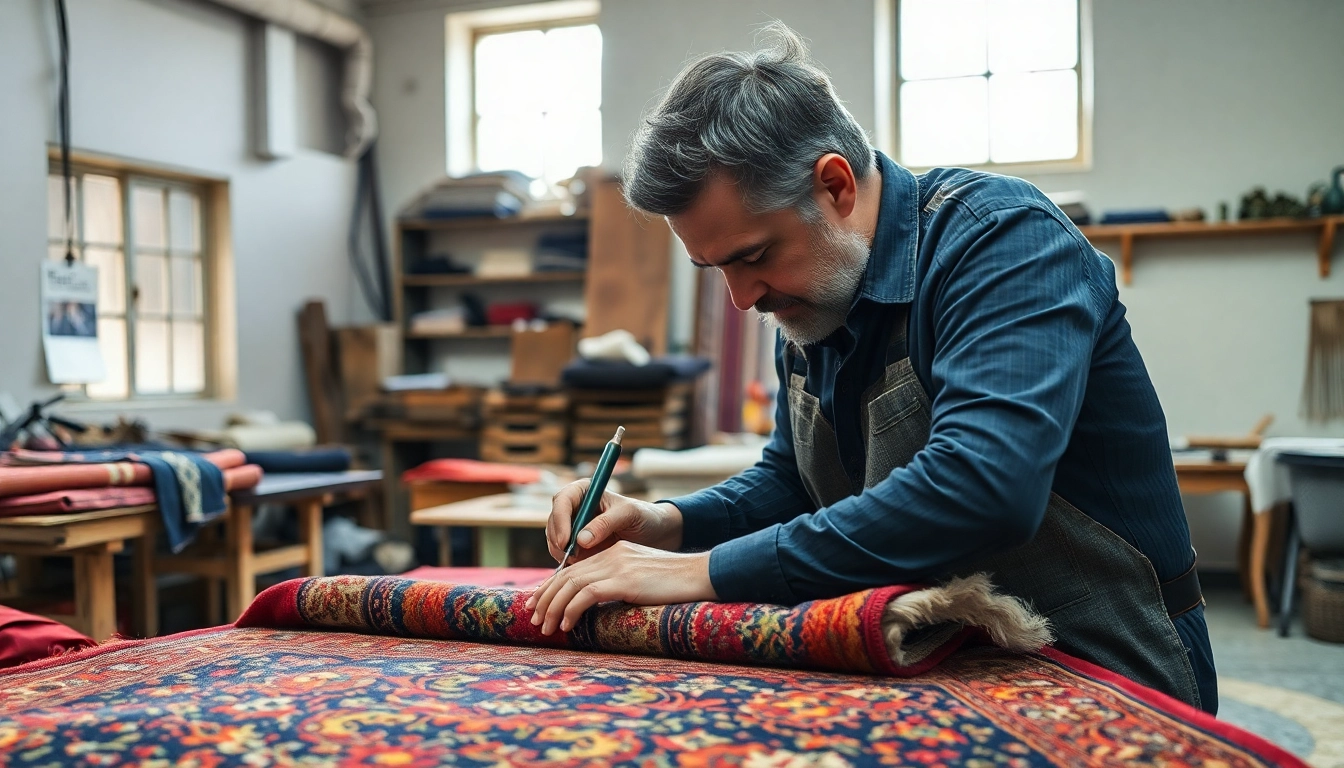Understanding Restauro Tappeti Milano: Techniques and Significance
Restoring valuable carpets, or restauro tappeti milano, is an intricate craft that combines artistry, historical knowledge, and precise technical skills. Milan, renowned for its rich cultural heritage and appreciation for fine arts and textiles, hosts numerous specialized workshops and ateliers dedicated to the preservation of both antique and modern rugs. The importance of professional restoration extends beyond mere aesthetic renewal; it preserves a piece of cultural history, maintains the integrity of the design, and enhances the longevity of valuable collections. Whether you own an ancient Persian rug or a contemporary art piece, understanding the techniques and significance of restauro tappeti is essential for appreciating its value and ensuring its preservation for future generations.
To delve into the world of professional restoration in Milan, it is crucial to explore the historical importance of tappeti restoration, common techniques employed by artisans, and how these practices differ from standard cleaning services. This comprehensive understanding enables collectors and homeowners to recognize expert intervention and makes informed decisions about their valuable assets. For those seeking top-tier services, knowing the core principles behind restoration can also guide effective communication with artisans and ensure optimal results.
Historical Importance of Tappeti Restoration in Milan
Milan has historically been a crossroads of cultural exchange, trade, and artistic innovation, making it an ideal hub for the preservation of cultural artifacts such as carpets. The city’s tradition of high craftsmanship and appreciation for textile arts has fostered a longstanding expertise in restauro tappeti. Historically, rugs served not only as functional items but also as symbols of status, art, and cultural identity.
The restoration movement in Milan gained momentum during the Renaissance, when art and craftsmanship became central to societal identity. As antique and traditional rugs began to age or suffer damage over time, local artisans developed meticulous methods to conserve their beauty and integrity. Today, Milan continues this tradition by combining age-old techniques with modern technology, ensuring that each restauro respects the original aesthetics while addressing contemporary preservation needs.
Key Restoration Techniques for Tappeti: Cleaning, Repair, and Preservation
Deep-Cleaning and Surface Restoration
Cleaning is the foundation of effective restoration, especially for rugs with accumulated dirt, stains, or biological contaminants. Expert restoration involves gentle, targeted cleaning methods such as hand washing with pH-neutral detergents, careful rinsing, and controlled drying environments. Milestones in cleaning include removing embedded dust and grime without damaging delicate fibers or dyes. Modern techniques also incorporate low-moisture and dry-cleaning options for sensitive or ancient pieces.
Damage Repair and Structural Reinforcement
Damage repair encompasses a variety of interventions aimed at restoring structural integrity. Common issues include frayed edges, holes, tears, fraying, and color fading. Skilled artisans employ techniques such as reweaving damaged areas with matching threads, patching with similar materials, and re-fringing edges to restore the original contour. For significant structural damages, reinforcement with backing fabrics ensures durability and prevents future deterioration.
Preservation and Long-Term Care
Preservation techniques involve applying protective measures like anti-UV coatings, pest deterrents, and environmental controls to minimize future damage. Proper storage, regular inspections, and controlled humidity and light exposure are critical components of long-term maintenance. Some Milanese ateliers also offer specialized curation, ensuring the rug’s environment supports its preservation and retains its value over decades.
Differences Between Restauro Tappeti and Regular Cleaning Services
While regular cleaning services focus primarily on removing surface dirt and residues, restauro tappeti involves a comprehensive approach addressing structural damage, dye degradation, and preservation of historical authenticity. Professional restoration is meticulous, often requiring disassembly, reweaving, and specialized dye treatments that are beyond the scope of standard cleaning companies.
Moreover, restoration artisans in Milan employ techniques that respect the original craftsmanship, ensuring the piece maintains its cultural and monetary value. Regular cleaning services may inadvertently damage delicate fibers or cause discoloration if improperly performed. Therefore, professional restauro is a vital investment in protecting the integrity and longevity of your carpets.
Step-by-Step Guide to Professional Restauro Tappeti Milano
Initial Assessment and Documentation of Rug Condition
The restoration process begins with a detailed evaluation of the rug’s condition. Experts examine fibers, dyes, structural integrity, and damage extent. Documentation is crucial, including photographic records and written assessments, to track progress and preserve records for future reference. Understanding the historical background of the rug can also influence restoration choices, especially for antique pieces where authenticity is paramount.
Careful Cleaning and Damage Repair Procedures
Following assessment, artisans proceed with tailored cleaning procedures. Damage repair involves meticulous reweaving, patching, and reinforcement, executed with precision to match original materials and techniques. For antique rugs, reversible and minimally invasive methods are prioritized to preserve authenticity. Often, advanced tools like microscopes and specialized dyes are employed to ensure harmony with existing features.
Final Restoration Steps and Long-Term Maintenance Tips
After physical repairs, finishing touches involve stabilizing colors, re-scaling fringe edges, and applying protective coatings. Restoration isn’t complete without guidance for long-term care. Experts recommend routine inspections, proper storage conditions, and minimal exposure to sunlight to prolong the benefits of their work. Scheduled maintenance and periodic professional check-ups help sustain the rug’s condition over time.
Choosing the Right Restauro Tappeti Milano Provider
Qualities of a Trusted Restauro Tappeti Service
Selecting an experienced provider requires evaluating their craftsmanship, reputation, and transparency. Look for artisans with certifications, years of experience, and a portfolio demonstrating diverse restoration projects. Customer testimonials and industry accreditations further attest to their professionalism and commitment to quality.
Questions to Ask Before Commencing Restoration Work
Before proceeding, inquire about their methods, materials used, estimated costs, and timeline. Ensure they guarantee reversibility of interventions and clarify the scope of work. Asking about insurance coverage and post-restoration support is also advisable, assuring you of comprehensive service and accountability.
Understanding Quotes and Cost Factors for Restauro Tappeti
The cost of restoring a rug varies widely, from as low as €50 for minor cleaning to thousands for extensive repair of priceless antiques. Factors influencing pricing include rug size, complexity of damage, age, materials, and the intricacy of techniques required. A reputable artisan provides a detailed quote, outlining each step and associated costs, ensuring transparency and value for your investment.
Benefits of Expert Restauro Tappeti Milano for Your Collection
Enhancing Rug Value and Aesthetic Appeal
Professional restoration revitalizes the original colors and patterns, often increasing its market value. Well-restored rugs exhibit a renewed vibrancy and clarity that appeal to collectors and interior designers alike, making your investment more attractive and maintaining its prestige.
Extending the Lifespan of Antique and Modern Tappeti
Quality restoration reinforces fibers and repairs damage, significantly prolonging the life of your rug. Regular maintenance and expert interventions prevent minor issues from escalating into irreparable damage, ensuring that your collection remains intact for generations.
Maintaining Authenticity and Cultural Heritage of Your Rugs
Authentic restoration respects the original craftsmanship and materials, preserving the cultural and artistic integrity of your rug. This approach maintains not only the aesthetic quality but also the historical narrative embedded in each piece, supporting cultural conservation efforts.
Performance Metrics and Aftercare for Restauro Tappeti
Indicators of Successful Restoration
Success in restoration is characterized by visual harmony, structural stability, and color retention. The rug should exhibit restored fibers, no visible repairs that disrupt design continuity, and improved resistance to future damage. Professional artisans also provide documentation certifying the completion and quality of work.
Regular Maintenance Practices Post-Restoration
To preserve restoration results, consistent cleaning with gentle methods is recommended. Avoid harsh chemicals or abrasive tools. Periodic professional inspections can identify early signs of deterioration, letting you address repairs promptly. Additionally, environmental controls—such as controlled humidity and limited sunlight—are essential for ongoing preservation.
Monitoring Rug Condition Over Time for Optimal Preservation
Maintaining a detailed record of inspections and any minor repairs helps monitor your rug’s condition. Mobile apps or dedicated conservation logs can assist in scheduling preventive maintenance, ultimately safeguarding your investment and allowing you to enjoy its beauty for decades.





